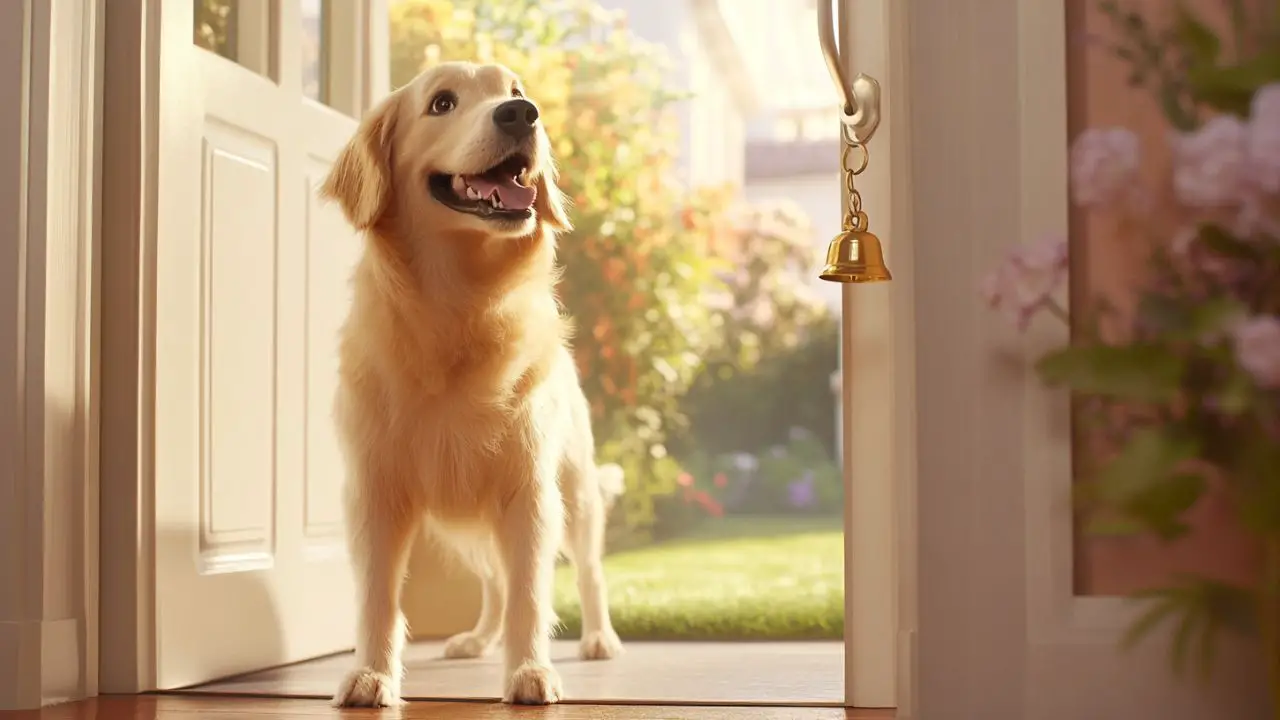Have you ever wished your dog could tell you when they need to go outside?
Teaching your furry friend to ring a bell is a clever and effective way to improve communication and prevent accidents in the house.
This method, known as “potty bell training,” can be a game-changer for both you and your canine companion.
Let’s explore how to teach this useful skill step by step.
Why Use a Bell?
Before we dive into the training process, let’s understand why bell ringing is beneficial.
Dogs can’t speak our language, but they’re excellent at learning associations.
A bell provides a clear, audible signal that’s easy for humans to recognize, even from another room.
This method gives your dog a specific way to communicate their needs, reducing confusion and frustration.
It’s especially useful for puppies still learning house training or for dogs in new environments.
Choosing the Right Bell
Selecting the appropriate bell is crucial for successful training.
Look for bells that are sturdy and produce a clear, distinct sound.
Hanging bells or a string of bells attached to a rope are popular choices.
Make sure the bell is at your dog’s nose level for easy access.
Avoid bells that are too loud or startling, as they might frighten your dog.
Setting Up the Bell
Place the bell near the door you typically use to let your dog out.
Consistency in location is key for your dog to form a strong association.
Ensure the bell is securely fastened and won’t fall or break if enthusiastically nudged.
You might need to adjust the height as your puppy grows if you’re starting with a young dog.
Introduction to the Bell
Begin by simply introducing your dog to the bell without any expectations.
Let them sniff and investigate the new object at their own pace.
Reward any interaction with the bell using treats and praise.
This positive association will make your dog more likely to engage with the bell in the future.
Teaching the ‘Touch’ Command
Before linking the bell to going outside, teach your dog to touch the bell on command.
Hold the bell in your hand and say “touch” while presenting it to your dog.
When your dog’s nose or paw makes contact with the bell, immediately reward them.
Repeat this process until your dog reliably touches the bell when you say “touch.”
Associating the Bell with Going Outside
Once your dog is comfortable touching the bell, it’s time to connect this action with going outside.
Every time you take your dog out, gently guide them to touch the bell before opening the door.
Use your “touch” command if needed, and always reward them for ringing the bell.
Immediately open the door after the bell rings to reinforce the connection.
Consistency is Key
Maintain a consistent routine every time your dog needs to go out.
Always use the same door and the same bell for potty breaks.
Encourage all family members to follow the same procedure to avoid confusing your dog.
Remember to be patient; some dogs may learn quickly, while others might take weeks to fully grasp the concept.
Dealing with False Alarms
As your dog becomes more comfortable with bell ringing, you might encounter some false alarms.
Your dog may ring the bell simply to go outside and play.
While it’s important to respond to the bell, keep outdoor trips brief if you suspect it’s not a genuine potty need.
This helps maintain the association between bell ringing and bathroom breaks.
Reinforcing the Behavior
Continue to praise and occasionally treat your dog for using the bell, even after they’ve mastered the skill.
This ongoing positive reinforcement helps maintain the behavior long-term.
Gradually reduce food rewards but maintain verbal praise and affection.
Your enthusiasm will help your dog understand that this communication method is valuable and appreciated.
Troubleshooting Common Issues
If your dog is hesitant to touch the bell, try smearing a small amount of peanut butter on it to encourage interaction.
For dogs who become overenthusiastic bell ringers, introduce a short wait time before opening the door to calm excessive excitement.
If progress stalls, go back a step in the training process and move forward more slowly.
Expanding the Skill
Once your dog has mastered bell ringing for potty breaks, you can potentially expand its use.
Some owners teach their dogs to use different bells or tones for different needs, like water or playtime.
However, be cautious not to overwhelm your dog with too many signals.
The primary goal is clear communication for essential needs.
Conclusion: A New Level of Canine Communication
Teaching your dog to ring a bell to go outside is more than just a neat trick.
It’s a valuable communication tool that can strengthen the bond between you and your furry friend.
This skill empowers your dog to clearly express their needs, reducing stress and potential accidents in the home.
Remember, every dog learns at their own pace, so be patient and consistent in your training approach.
With time and positive reinforcement, your dog will be ringing that bell with confidence, making life easier and more harmonious for both of you.
Share this guide with fellow dog owners and start your bell-ringing adventure today!
Your furry friend will thank you for the newfound ability to “speak” their mind.
SHARE now with your friends!
- Hero Farm Dog Survives Epic Battle with Coyote Pack - December 9, 2024
- The 10-Minute Bedtime Routine That Changed My Dog’s Sleep Forever - November 29, 2024
- Creating a Safe Space for Nervous Pets: Your Guide to Pet-Friendly Havens - November 25, 2024

